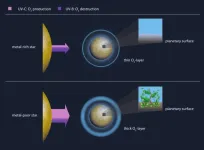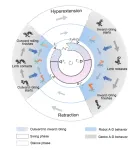(Press-News.org) Stars that contain comparatively large amounts of heavy elements provide less favourable conditions for the emergence of complex life than metal-poor stars, as scientists from the Max Planck Institutes for Solar System Research and for Chemistry as well as from the University of Göttingen have now found. The team showed how the metallicity of a star is connected to the ability of its planets to surround themselves with a protective ozone layer. Crucial to this is the intensity of the ultraviolet light that the star emits into space, in different wavelength ranges. The study provides scientists searching the sky with space telescopes for habitable star systems with important clues as to where this endeavour could be particularly promising. It also suggests a startling conclusion: as the universe ages, it becomes increasingly unfriendly to the emergence of complex life on new planets.
In the search for habitable or even inhabited planets orbiting distant stars, researchers have in the past years increasingly focused on the gas envelopes of these worlds. Do observational data show evidence of an atmosphere? Does it perhaps even contain gases such as oxygen or methane, which on Earth are produced almost exclusively as metabolic products of lifeforms? In the next years, such observations will be pushed to new limits: Nasa’s James Webb Telescope will make it possible to not only characterize the atmospheres of large gas giants like Super-Neptunes, but also to analyze for the first time the much fainter spectrographic signals from rocky planet atmospheres.
With the help of numerical simulations, the current study, which was published in Nature Communications today, now turns to the ozone content of exoplanet atmospheres. As on Earth, this compound of three oxygen atoms can protect the planet's surface (and life forms residing on it) from cell-damaging ultraviolet (UV) radiation. A protective layer of ozone is thus an important prerequisite for the emergence of complex life. "We wanted to understand what properties a star must have in order for its planets to form a protective ozone layer," Anna Shapiro, scientist at the Max Planck Institute for Solar System Research and first author of the current study, explains the basic idea.
As often in science, this idea was triggered by an earlier finding. Three years ago, researchers led by the Max Planck Institute for Solar System Research had compared the Sun's brightness variations with those of hundreds of Sun-like stars. The result: the intensity of the visible light from many of these stars fluctuates much more strongly than in the case of the Sun. “We saw huge peaks in intensity”, says Alexander Shapiro, who was involved in both the analyses from three years ago and the current study. “It is therefore quite possible, that the Sun, too, is capable of such spikes in intensity. In that case, also the intensity of the ultraviolet light would increase dramatically”, he adds. “So naturally we wondered, what this would mean for life on Earth and what the situation is like in other star systems”, says Sami Solanki, director at the Max Planck Institute for Solar System Research and co-author of both studies.
Dual role of UV radiation
At the surface of about half of all stars around which exoplanets have been shown to orbit, temperatures range from about 5,000 to about 6,000 degrees Celsius. In their calculations, the researchers therefore turned to this subgroup. With a surface temperature of approximately 5500 degrees Celsius, the Sun is also one of them. "In the Earth’s atmospheric chemistry, ultraviolet radiation from the Sun plays a dual role," explains Anna Shapiro, whose past research interest focused on the influence of solar radiation on Earth's atmosphere. In reactions with individual oxygen atoms and oxygen molecules, ozone can both be created and destroyed. While long-wave UV-B radiation destroys ozone, short-wave UV-C radiation helps create protective ozone in the middle atmosphere. "It was therefore reasonable to assume that ultraviolet light may have a similarly complex influence on exoplanet atmospheres as well”, the astronomer adds. The precise wavelengths are crucial.
The researchers therefore calculated exactly which wavelengths make up the ultraviolet light emitted by the stars. For the first time, they also considered the influence of metallicity. This property describes the ratio of hydrogen to heavier elements (simplistically and somewhat misleadingly called “metals” by astrophysicists) in the building material of the star. In the case of the Sun, there are more than 31000 hydrogen atoms for every iron atom. The study also considered stars with lower and higher iron content.
Simulated interactions of UV radiation with gases
In a second step, the team investigated how the calculated UV radiation would affect the atmospheres of planets orbiting at a life-friendly distance around these stars. Life-friendly distances are those that allow moderate temperatures - neither too hot nor too cold for liquid water - at the planet's surface. For such worlds, the team simulated on the computer exactly which processes the parent star’s characteristic UV light sets in motion in the planet's atmosphere.
To compute the composition of planetary atmospheres the researchers used a chemistry-climate model that simulates the processes that control oxygen, ozone, and many other gases, and their interactions with ultraviolet light from stars, at very high spectral resolution. This model allowed the investigation of a wide variety of conditions on exoplanets and comparison with the history of the Earth’s atmosphere in the last half billion years. During this period the high atmospheric oxygen content and the ozone layer were established that allowed the evolution of life on land on our planet. “It is feasible that the history of the Earth and its atmosphere holds clues about the evolution of life that may also apply to exoplanets” says Jos Lelieveld, Managing Director of the Max Planck Institute for Chemistry, who was involved in the study.
Promising candidates
The results of the simulations were surprising for the scientists. Overall, metal-poor stars emit more UV radiation than their metal-rich counterparts. But the ratio of ozone-generating UV-C radiation to ozone-destroying UV-B radiation also depends critically on metallicity: in metal-poor stars, UV-C radiation predominates, allowing a dense ozone layer to form. For metal-rich stars, with their predominant UV-B radiation, this protective envelope is much more sparse. "Contrary to expectations, metal-poor stars should thus provide more favourable conditions for the emergence of life," Anna Shapiro concludes.
This finding could be helpful for future space missions such as Esa's Plato mission, which will comb through a vast array of stars for signs of habitable exoplanets. With 26 telescopes on board, the eponymous probe will be launched into space in 2026 and will focus its attention primarily on Earth-like planets orbiting Sun-like stars at life-friendly distances. The mission's data centre is currently being set up at the Max Planck Institute for Solar System Research. "Our current study gives us valuable clues as to which stars Plato should pay special attention to," says Laurent Gizon, Managing Director at the Institute and co-author of the current study.
Paradoxical conclusion
Moreover, the study yields an almost paradoxical conclusion: as the universe ages, it is likely to become increasingly hostile to life. Metals and other heavy elements are formed inside stars at the end of their several-billion-year lifetimes and - depending on the mass of the star - are released into space as stellar wind or in a supernova explosion: the building material for the next generation of stars. "Each newly forming star therefore has more metal-rich building material available than its predecessors. Stars in the universe are becoming more metal-rich with each generation," says Anna Shapiro. According to the new study, the probability that star systems will produce life thus also decreases as the universe ages. However, the search for life is not hopeless. After all, many host stars of exoplanets have a similar age as the Sun. And this star is indeed known to harbour complex and interesting lifeforms on at least one of its planets.
END
Metal-poor stars are more life-friendly
A star’s chemical composition strongly influences the ultraviolet radiation it emits into space and thus the conditions for the emergence of life in its neighborhood
2023-04-18
ELSE PRESS RELEASES FROM THIS DATE:
Quantum liquid becomes solid when heated
2023-04-18
Supersolids are a relatively new and exciting area of research. They exhibit both solid and superfluid properties simultaneously. In 2019, three research groups were able to demonstrate this state for the first time beyond doubt in ultracold quantum gases, among them the research group led by Francesca Ferlaino from the Department of Experimental Physics at the University of Innsbruck and the ÖAW Institute for Quantum Optics and Quantum Information (IQOQI) in Innsbruck.
In 2021, Francesca Ferlaino's team studied in detail the life cycle of supersolid states ...
Researchers ID gene that shapes heart attack, aneurysm risk
2023-04-18
University of School of Medicine researchers have identified a gene that plays a crucial role in determining our risk for heart attacks, deadly aneurysms, coronary artery disease and other dangerous vascular conditions.
The discovery advances our understanding of the underlying causes of a wide range of serious health conditions, including atherosclerosis (hardening of the arteries), and moves us closer to new treatments and preventive measures that could help people live longer, healthier lives.
“The first step towards translating the knowledge of population risk for vascular disease is disentangling the fundamental cellular ...
Extreme poverty a key driver for relapse in kids with ALL
2023-04-18
(WASHINGTON, DC, April 18, 2023) – Children with acute lymphoblastic leukemia (ALL) who live in extreme poverty and were undergoing maintenance therapy faced an almost two-fold greater risk of relapse compared with kids who weren’t as poor, according to a study published in today’s issue of Blood. Moreover, a higher proportion of these children had difficulty adhering to treatment, though researchers said this only partially explains the link between poverty and the risk of relapse.
“ALL is a curable disease, so while we observed relatively few relapses in total, children living in extreme poverty – those whose families were really stretched thin and not able ...
Study: vitamin D may play a role in prostate cancer disparities
2023-04-18
Vitamin D deficiency could be the reason African American men experience more aggressive prostate cancer at a younger age compared with European American men, new research from Cedars-Sinai Cancer suggests. The multi-institutional study, published today in Cancer Research Communications, a journal of the American Association for Cancer Research (AACR), could pave the way for revised nutritional guidelines.
While previous research has investigated vitamin D in the context of health disparities, this is the first study to look at its functions in a genome-wide manner in African American versus European American ...
Announcing inaugural Hevolution/AFAR New Investigator Awards in Aging Biology and Geroscience
2023-04-18
New York, New York — The American Federation for Aging Research (AFAR) and Hevolution Foundation are pleased to announce the inaugural Hevolution/AFAR New Investigator Awards in Aging Biology and Geroscience Research recipients. Eighteen three-year awards of US $375,000 each have been granted to support research projects in basic biology of aging or geroscience — a research paradigm based on addressing the biology of ...
Teasing strange matter from the ordinary
2023-04-18
NEWPORT NEWS, VA – In a unique analysis of experimental data, nuclear physicists have made the first-ever observations of how lambda particles, so-called “strange matter,” are produced by a specific process called semi-inclusive deep inelastic scattering (SIDIS). What’s more, these data hint that the building blocks of protons, quarks and gluons, are capable of marching through the atomic nucleus in pairs called diquarks, at least part of the time. These results come from an experiment conducted at the U.S. Department of Energy’s Thomas Jefferson National Accelerator Facility.
It’s a result that has been ...
Study provides evidence that peer-support groups can be beneficial in reducing healthcare worker stress and burnout
2023-04-18
INDIANAPOLIS – Serving on the front lines in the arduous battle against the coronavirus, emergency department (ED) physicians are among the true heroes of the pandemic, working long, stressful hours at great personal risk, especially in the many months before vaccines became available. A pilot study examining the feasibility, receptivity and preliminary effectiveness of peer-support groups for ED doctors during COVID-19 found this support provided potential benefit in terms of reduction of mental health stresses involved in emergency care during this time.
The researchers assessed change in symptoms of distress, depression and burnout before and after participating ...
Narrative risk messaging and vaccine hesitancy
2023-04-18
Public health messages that focus on protecting others are more effective at increasing vaccination rates than messages focused on protecting oneself, according to a study. Vaccine hesitancy is a challenge for public health workers and others concerned with reducing the deleterious effects of infectious diseases. Elizabeth Shanahan and colleagues tested three visual policy narrative messages promoting COVID-19 vaccination that emphasized protecting oneself, one’s circle of friends and family, or one’s community. A non-narrative control message simply urged participants to “get the vaccine” with an accompanying image of a syringe. ...
A neural coordination strategy for attachment and detachment of a climbing robot inspired by gecko locomotion
2023-04-18
A research article by scientists at the Nanjing University of Aeronautics and Astronautics developed a neural control algorithm to coordinate the adhesive toes and limbs of the climbing robot. The new research article, published in the journal Cyborg and Bionic Systems, provided a novel hybrid-driven climbing robot and introduced a neural control method based on CPG (Central Pattern Generator) for coordinating between adhesion and motion.
“Currently, the movement speed and stability of climbing robots have not yet reached the level of biological organisms. Animals have flexible climbing abilities on various slopes and roughness, ...
Children with COVID-19 treated safely at home, helping to take burden off hospitals
2023-04-18
Children with COVID-19 can be treated safely at home, helping to take the burden off the hospital system, according to a new study.
The research, led by Murdoch Children’s Research Institute and published in Archives of Disease in Childhood, found COVID-positive children with moderate symptoms or pre-existing high-risk conditions could be treated effectively via a Hospital-in-the-Home (HITH) program. Additionally, many more sick children without COVID-19 were treated at home during the pandemic.
Murdoch Children’s Dr Laila Ibrahim said the program took pressure off paediatric emergency departments ...
LAST 30 PRESS RELEASES:
SIMJ announces global collaborative book project in commemoration of its 75th anniversary
Air pollution exposure and birth weight
Obstructive sleep apnea risk and mental health conditions among older adults
How talking slows eye movements behind the wheel
The Ceramic Society of Japan’s Oxoate Ceramics Research Association launches new international book project
Heart-brain connection: international study reveals the role of the vagus nerve in keeping the heart young
Researchers identify Rb1 as a predictive biomarker for a new therapeutic strategy in some breast cancers
Survey reveals ethical gaps slowing AI adoption in pediatric surgery
Stimulant ADHD medications work differently than thought
AI overestimates how smart people are, according to HSE economists
HSE researchers create genome-wide map of quadruplexes
Scientists boost cell "powerhouses" to burn more calories
Automatic label checking: The missing step in making reliable medical AI
Low daily alcohol intake linked to 50% heightened mouth cancer risk in India
American Meteorological Society announces Rick Spinrad as 2026 President-Elect
Biomass-based carbon capture spotlighted in newly released global climate webinar recording
Illuminating invisible nano pollutants: advanced bioimaging tracks the full journey of emerging nanoscale contaminants in living systems
How does age affect recovery from spinal cord injury?
Novel AI tool offers prognosis for patients with head and neck cancer
Fathers’ microplastic exposure tied to their children’s metabolic problems
Research validates laboratory model for studying high-grade serous ovarian cancer
SIR 2026 delivers transformative breakthroughs in minimally invasive medicine to improve patient care
Stem Cell Reports most downloaded papers of 2025 highlight the breadth and impact of stem cell research
Oxford-led study estimates NHS spends around 3% of its primary and secondary care budget on the health impacts of heat and cold in England
A researcher’s long quest leads to a smart composite breakthrough
Urban wild bees act as “microbial sensors” of city health.
New study finds where you live affects recovery after a hip fracture
Forecasting the impact of fully automated vehicle adoption on US road traffic injuries
Alcohol-related hospitalizations from 2016 to 2022
Semaglutide and hospitalizations in patients with obesity and established cardiovascular disease
[Press-News.org] Metal-poor stars are more life-friendlyA star’s chemical composition strongly influences the ultraviolet radiation it emits into space and thus the conditions for the emergence of life in its neighborhood






